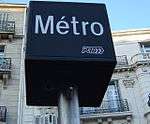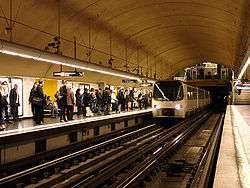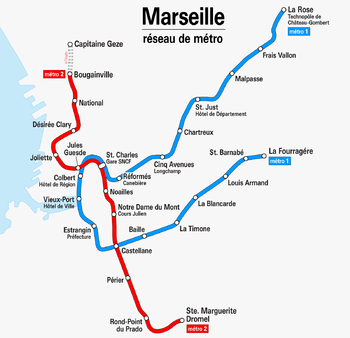Marseille Metro
|
At Castellane station | |||||||||||||||||||||||||||||||||||||||||||||||||||||||||||||||||||||||||||||||||||||||||||||||||||||||||||||||||||||||||||||||||||||
| Overview | |||||||||||||||||||||||||||||||||||||||||||||||||||||||||||||||||||||||||||||||||||||||||||||||||||||||||||||||||||||||||||||||||||||
|---|---|---|---|---|---|---|---|---|---|---|---|---|---|---|---|---|---|---|---|---|---|---|---|---|---|---|---|---|---|---|---|---|---|---|---|---|---|---|---|---|---|---|---|---|---|---|---|---|---|---|---|---|---|---|---|---|---|---|---|---|---|---|---|---|---|---|---|---|---|---|---|---|---|---|---|---|---|---|---|---|---|---|---|---|---|---|---|---|---|---|---|---|---|---|---|---|---|---|---|---|---|---|---|---|---|---|---|---|---|---|---|---|---|---|---|---|---|---|---|---|---|---|---|---|---|---|---|---|---|---|---|---|---|
| Native name | Métro de Marseille | ||||||||||||||||||||||||||||||||||||||||||||||||||||||||||||||||||||||||||||||||||||||||||||||||||||||||||||||||||||||||||||||||||||
| Locale | Marseille, Provence-Alpes-Côte d'Azur, France | ||||||||||||||||||||||||||||||||||||||||||||||||||||||||||||||||||||||||||||||||||||||||||||||||||||||||||||||||||||||||||||||||||||
| Transit type | Rapid transit | ||||||||||||||||||||||||||||||||||||||||||||||||||||||||||||||||||||||||||||||||||||||||||||||||||||||||||||||||||||||||||||||||||||
| Number of lines | 2[1] | ||||||||||||||||||||||||||||||||||||||||||||||||||||||||||||||||||||||||||||||||||||||||||||||||||||||||||||||||||||||||||||||||||||
| Number of stations | 28[1] | ||||||||||||||||||||||||||||||||||||||||||||||||||||||||||||||||||||||||||||||||||||||||||||||||||||||||||||||||||||||||||||||||||||
| Daily ridership | 210,200 (daily avg., 2012)[2] | ||||||||||||||||||||||||||||||||||||||||||||||||||||||||||||||||||||||||||||||||||||||||||||||||||||||||||||||||||||||||||||||||||||
| Annual ridership | 76.7 million (2012)[2] | ||||||||||||||||||||||||||||||||||||||||||||||||||||||||||||||||||||||||||||||||||||||||||||||||||||||||||||||||||||||||||||||||||||
| Operation | |||||||||||||||||||||||||||||||||||||||||||||||||||||||||||||||||||||||||||||||||||||||||||||||||||||||||||||||||||||||||||||||||||||
| Began operation | 1977 | ||||||||||||||||||||||||||||||||||||||||||||||||||||||||||||||||||||||||||||||||||||||||||||||||||||||||||||||||||||||||||||||||||||
| Operator(s) | RTM | ||||||||||||||||||||||||||||||||||||||||||||||||||||||||||||||||||||||||||||||||||||||||||||||||||||||||||||||||||||||||||||||||||||
| Technical | |||||||||||||||||||||||||||||||||||||||||||||||||||||||||||||||||||||||||||||||||||||||||||||||||||||||||||||||||||||||||||||||||||||
| System length | 21.5 km (13.4 mi)[1] | ||||||||||||||||||||||||||||||||||||||||||||||||||||||||||||||||||||||||||||||||||||||||||||||||||||||||||||||||||||||||||||||||||||
| Track gauge | 1,435 mm (4 ft 8 1⁄2 in) standard gauge | ||||||||||||||||||||||||||||||||||||||||||||||||||||||||||||||||||||||||||||||||||||||||||||||||||||||||||||||||||||||||||||||||||||
| |||||||||||||||||||||||||||||||||||||||||||||||||||||||||||||||||||||||||||||||||||||||||||||||||||||||||||||||||||||||||||||||||||||
The Marseille Metro (French: Métro de Marseille) is a metro/rapid transit system serving the city of Marseille, in southern France. The Marseille Metro opened in 1977. As of 2013, the system comprises two lines, partly underground, serving 28 stations, with an overall route length of 21.5 kilometres (13.4 mi).[1] It carried approximately 76.7 million passengers in 2012.[2] The Metro uses the rubber-tyred metro technology derived from some lines of the Paris Metro.
History
The first plans for a metro system in Marseille appeared in the early years of the 20th century, following the opening of the Paris metro.[3] Many plans were put forward, but quickly abandoned due to lack of financing. The most serious proposal emanated in 1918 from the Compagnie d'électricité de Marseille, which proposed to build an underground network similar to the Paris métro. This proposal was met with fierce opposition from the Compagnie générale française de tramways, which owned and operated the city's tramway system. This project ultimately failed, and the idea of building a metro in Marseille was abandoned for many decades.
The tramway system, badly damaged during the Second World War, was almost completely scrapped during the 1950s and replaced by buses (with the exception of line 68). However, by 1960, the city was suffering from severe congestion due to the growth in automobile use. New metro projects resurfaced in the mid-1960s, as a means to alleviate traffic congestion. After several years of studies, the city council voted unanimously in 1969 for the creation of a metro system.[4]
Construction of the first line started on August 13, 1973 and lasted until early 1977.[5] Revenue operation started on November 26, 1977 on a portion of the line, between La Rose and Saint-Charles. The rest of the line opened on March 11, 1978. The plans for the second line were approved in 1978. Construction began in 1980.[6] The central portion of the line, between Joliette and Castellane, opened on March 3, 1984. Southern and northern portions of the line were opened in February 1986 and February 1987 respectively.
Subsequent extensions took place in the following years on line 1, first between Castellane and La Timone on September 5, 1992 (1.5 km, 2 new stations),[7] and then between La Timone and La Fourragère (2.5 km, 4 new stations) in 2010.[8]
Current network
Rolling stock
The rolling stock comprises 36 4-car trains, named MPM 76.[9] Trains have a capacity of 472 passengers (including 182 seats). MPM 76 trains use the rubber tyre metro technology developed by the RATP for the Paris métro.
Trains were built in Valenciennes, France, by a group of French companies which are now part of Alstom group. A first batch of 21 3-car trains was delivered in 1976, for line 1. A second batch of 15 was delivered in 1983, for line 2. In 1985, a fourth car was aded on every train, in order to increase capacity.
Commercial operation

The metro system is operated by the Régie des Transports de Marseille, on behalf of the Urban Community of Marseille Provence Métropole, which owns the infrastructure as well as the rolling stock.
Service is open every day, from 5AM to 1AM the next day. Trains run every 3 minutes during rush hour, and every 10 minutes during evenings.
The metro system transported 76.7 million passengers in 2012,[2] leading to an average daily ridership of over 210,000.
Planned developments
A 900-metre (0.56 mi) long extension of line 2 to Capitaine Gèze is expected to open in 2015,[1] north of the current terminus station Bougainville.[10][11] The new Capitaine Gèze station will feature a bus station and a park and ride facility. This short extension will reuse existing service tracks that currently lead to the Zoccola depot. The cost is estimated to be 80 million euros.
Several other long-term extensions, including a southern extension of line 2 from Sainte-Marguerite to St-Loup, are being considered.
The replacement of the MPM76 rolling stock is expected to take place by the year 2020.[12] However, no decision has been made as of January 2013.
See also
References
- 1 2 3 4 5 "Fiche d'identité de l'Entreprise - LE METRO" [ID card of the company - THE METRO]. rtm.fr (in French). Retrieved September 28, 2013.
- 1 2 3 4 "Fiche d'identité de l'Entreprise - LE TRANSPORT AU COEUR DE NOTRE MISSION : Un Réseau Intégré" [ID card of the company - TRANSPORT AT THE HEART OF OUR MISSION: An Integrated Network]. rtm.fr (in French). Retrieved September 28, 2013.
- ↑ (Laupiès 1993, pp. 49–56)
- ↑ (Laupiès 1993, pp. 71–81)
- ↑ (Laupiès 1993, pp. 81–86)
- ↑ (Laupiès 1993, pp. 86–95)
- ↑ (Laupiès 1993, pp. 104–114)
- ↑ Jean-Jacques Fiorito (May 5, 2010). "Marseille : le métro s'offre quatre nouvelles stations". La Provence (in French).
- ↑ Bochet, Henri (March 1980). "Le métro de Marseille". Revue générale des chemins de fer (in French). Dunod: 139–146. ISSN 0035-3183.
- ↑ Vinzent, Julien (June 6, 2011). "Bus, cars, voitures et vélos auront rendez-vous au futur métro capitaine Gèze". www.marsactu.fr.
- ↑ Fiorito, Jean-Jacques (September 27, 2011). "Marseille : et voici le futur terminus de la ligne 2 du métro". La Provence (in French).
- ↑ Vinzent, Julien (May 25, 2012). "Le renouvellement du métro coûtera "plusieurs centaines de millions d'euros"". www.marsactu.fr (in French).
Bibliography
- Laupiès, Jacques (1993). Marseille et son Métro (in French). Éditions Paul Tacussel. ISBN 2903963665.
- Groneck, Christoph (2006). Metros in France. Robert Schwandl Verlag. ISBN 978-3936573138.
External links
![]() Media related to Marseille Metro at Wikimedia Commons
Media related to Marseille Metro at Wikimedia Commons
- Marseille Metro Map on Google earth with geolocation
- RTM – official website (English)
- Marseille at UrbanRail.net (English)

